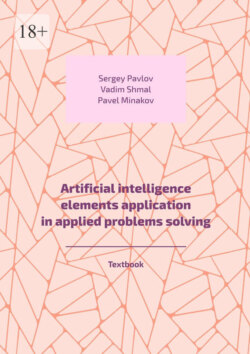Читать книгу Artificial intelligence elements application in applied problems solving. Textbook - Vadim Shmal - Страница 7
Simulation intelligence
ОглавлениеThe general problem of modeling (or creating) intelligence is divided into subtasks. They consist of certain traits or capabilities that researchers expect from an intelligent system. The traits described below have attracted the most attention in the past, although this list is far from exhaustive.
Design (construction) of intelligence. Imitation of intelligence. Show intelligence.
The first concerns the availability of intelligent systems capable of simulating the behavior observed in a wide range of situations and conditions. It is often assumed that artificial intelligence systems will be built to replicate many of the features displayed by real intelligence, with the intention of eventually showing that real intelligence is possible.
The demo part is dedicated to demonstrating real intelligence. This suggests that true intelligent systems exist.
We have specific examples of real intelligent systems with large datasets. Such systems run useful algorithms in real situations. Algorithms do not necessarily mimic the behavior observed in the real world; however, they were designed to achieve specific goals.
Applications of intelligence include the recognition of events and actions that are not explicitly defined by current human programming. This is a characteristic of artificial intelligence systems, which today is called predictive intelligence.
Detection of types of objects and objects. Identification of various objects or details. Recognition of information associated with these objects. Create object or information representations. Interpretation of information. Analysis of information represented by objects. Establishing relationships between objects. These are examples of intelligence in computer science. Examples include image processing algorithms, networks, knowledge bases, virtual computing environments (supercomputers), and artificial neural networks (artificial neurons).
In the field of computer science, artificial intelligence and artificial neural networks are considered artificial intelligence systems. Thus, artificial intelligence is defined as «the development of intelligent systems that can simulate complex intelligence that can have human-like computing power.»
Building intelligent systems requires a proper understanding of intelligence. This means developing smarter systems with the right understanding of intelligence. This includes the development of intelligent systems that can mimic cognitive processes, human perception, human thinking.
Intelligence in Cognitive Systems Design and build intelligent systems capable of simulating complex cognitive behavior. These systems must be extremely complex and reliable. More complex cognitive behavior requires more powerful computational and computational resources. Understanding and improvement of computational processes and mechanisms of intelligence. There are three aspects that are involved in understanding and improving the computational processes and mechanisms of intelligent systems: cognitive systems, cognitive science, and cognitive psychology.
The study of intelligent systems that mimic complex cognitive behavior
Research and development of intelligent systems that mimic complex cognitive behavior is a scientific research aimed at developing more intelligent systems. Such systems are needed to simulate complex cognitive behavior. These systems must be extremely intelligent and powerful.
An important point in research and development in the field of artificial intelligence is that we must develop artificial intelligence that mimics complex cognitive behavior. More complex cognitive behavior requires more powerful computational and computational resources. Therefore, in order for scientists and engineers to create intelligent systems, we need to spend more computing resources.
This leads to the question: how much computing power is required to create more intelligent systems?
First, we need to understand and define intelligence. We define intelligence as an intelligent system that can act as an intelligent system. Thus, the intelligent system mimics complex cognitive behavior. The system can simulate various types of cognitive behavior. However, how complex this cognitive behavior is is a matter of debate. This is a question that requires an answer from more complex cognitive models of behavior. In addition, we need to decide how we can build smarter systems.
Second, we need to understand and define learning. Learning is a learning process followed by the evolution of an intelligent system. Learning is an action that is necessary to receive a reward. This is what people do. Similarly, intelligent systems learn to perform more complex cognitive activities. Intelligent systems learn more complex cognitive behaviors in their environment. When used in different environments, they learn to perform more complex cognitive activities.
Third, we must create systems that mimic certain complex cognitive behaviors. There are two types of systems that are used to simulate complex cognitive behavior. The first is called evolutionary computation. Evolutionary computing is a mechanism for constructing more complex cognitive models of behavior. In a sense, evolution is a mechanism for creating smarter cognitive behavior. In addition, evolution is a mechanism for building more complex cognitive models of behavior. It is also used in machine learning. In other words, it is a mechanism that allows intelligent systems to learn and perform more complex cognitive actions. Another mechanism that mimics complex cognitive behavior is modeling. Modeling is a mechanism for modeling cognitive behavior.
This knowledge is needed by scientists and engineers. This knowledge is important for scientists and engineers. They need to know what is required in research and development in the field of artificial intelligence.
All these steps require more computing resources to create more intelligent systems. More complex cognitive behavior requires more powerful computational and computational resources.
There are five types of artificial intelligence systems. First, there are software systems. Software systems are artificial intelligence systems that are simulated on computers. The second is hardware systems. These are artificial intelligence systems that are simulated on computers and ultimately create and mimic the physical behavior of real objects. The third one is convergent algorithms. Convergent algorithms are algorithms that are trained and imitated by machines. The fourth is cause-and-effect algorithms. These are algorithms that mimic physical behavior. It is the most important machine learning algorithm. The last type is evolutionary algorithms. Evolutionary algorithms are systems that mimic the behavior of biological animals and plants.
